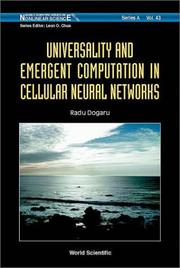| Listing 1 - 2 of 2 |
Sort by
|

ISBN: 1281876887 9786611876883 9812564500 9789812564504 9789812381026 9812381023 9812381023 Year: 2003 Publisher: Singapore River Edge, NJ World Scientific
Abstract | Keywords | Export | Availability | Bookmark
 Loading...
Loading...Choose an application
- Reference Manager
- EndNote
- RefWorks (Direct export to RefWorks)
Cellular computing is a natural information processing paradigm,capable of modeling various biological, physical and social phenomena,as well as other kinds of complex adaptive systems. The programmingof a cellular computer is in many respects similar to the geneticevolution in biology, the result being a proper cell design and atask-specific gene.
Neural networks (Computer science) --- Cellular automata. --- Computational complexity. --- Complexity, Computational --- Electronic data processing --- Machine theory --- Computers, Iterative circuit --- Iterative circuit computers --- Structures, Tessellation (Automata) --- Tessellation structures (Automata) --- Parallel processing (Electronic computers) --- Pattern recognition systems --- Sequential machine theory --- Artificial neural networks --- Nets, Neural (Computer science) --- Networks, Neural (Computer science) --- Neural nets (Computer science) --- Artificial intelligence --- Natural computation --- Soft computing --- Neural networks (Computer science).
Book
ISBN: 9783540768012 Year: 2008 Publisher: Berlin, Heidelberg Springer-Verlag Berlin Heidelberg
Abstract | Keywords | Export | Availability | Bookmark
 Loading...
Loading...Choose an application
- Reference Manager
- EndNote
- RefWorks (Direct export to RefWorks)
Cellular nonlinear networks are naturally inspired computing architectures where complex dynamic behaviors may emerge as a result of the local or prescribed connectivity among simple cells. Functionally, much like in biology, each cell is defined by a few bits of information called a gene. Such systems may be used in signal processing applications (intelligent sensors) or may be used to model and understand natural systems. While many publications focus on the dynamics in cellular automata and various applications, less deal with an important problem, that of designing for emergence. Put in simple words: How to choose a cell such that a desired behavior will occur in the cellular system. This book proposes a systematic framework for measuring emergence and a systematic design method to locate computationally meaningful genes in a reasonable computing time. Programs and application examples are provided so that the reader may easily understand the new concepts and develop her own specific experiments. An accessible language recommends it to a large audience including specialists from various interdisciplinary fields who may benefit from a better understanding of emergence and its applications to their specific field.
| Listing 1 - 2 of 2 |
Sort by
|

 Search
Search Feedback
Feedback About UniCat
About UniCat  Help
Help News
News